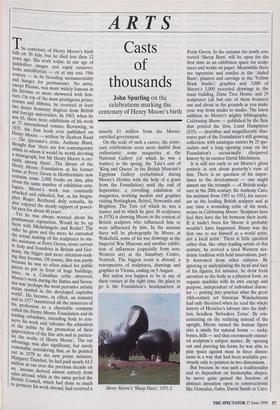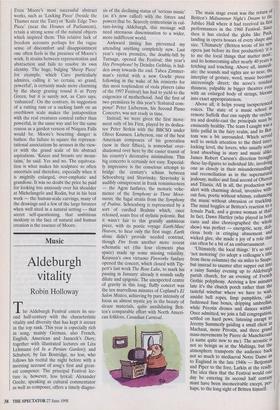ARTS
Casts of thousands
John Spurling on the celebrations marking the centenary of Henry Moore's birth
The centenary of Henry Moore's birth falls on 30 July, but he died less than 12 years ago. His work today, in our age of quicksilver images and rapid turnover, looks antediluvian — or at any rate 19th century — in its brooding monumentality and hunger for permanence. No artist, except Picasso, was more widely famous in his lifetime or more showered with hon- ours. On top of the most prestigious prizes, crosses and ribbons, he received at least two dozen honorary degrees from British and foreign universities. In 1983, when he was 85, there were exhibitions of his work at 77 international venues. Reviewing, in 1935, the first book ever published on Henry Moore — written by Herbert Read The Spectator's critic, Anthony Blunt, thought that 'there are few contemporary artists to whom it would be worth devoting a monograph, but Mr Henry Moore is cer- tainly among them'. The library of the home Moore Foundation at his former nonle at Perry Green in Hertfordshire now contains some 2,000 books on him, plus about the same number of exhibition cata- logues. Moore's work was constantly attacked and ridiculed, but, as his biogra- pher Roger Berthoud drily remarks, he also 'enjoyed the steady support of power- ful men for about 40 years'. Yet he was always worried about his posthumous reputation. Would he be up there with Michelangelo and Rodin? The older he grew and the more he entrusted the actual making of his sculptures to stu- dio assistants at Perry Green, stone carvers in Italy and foundries in Britain and Ger- many, the bigger and more attention-seek- ing they became. Of course, this was partly because he was so often asked for public pieces to put in front of huge buildings, since, as a Canadian critic observed, Moore's work during the Sixties and Seven- ties was 'perhaps the most pervasive artistic status symbol in the developed capitalist world'. He became, in effect, an industry and in 1977 transferred all the resources of his profession to a charitable company called the Henry Moore Foundation and its trading subsidiary, intending both to con- serve his work and 'advance the education of the public by the promotion of their appreciation of the fine arts and in particu- lar the works of Henry Moore'. The tax advantage was also significant, but surely reasonable considering that, as he pointed out in 1979 to the new prime minister, Margaret Thatcher, he had paid nearly £4.5 million in tax over the previous decade on an income derived almost entirely from sales abroad, while in the same period the British Council, which had done so much to promote his work abroad, had received a miserly £1 million from the Moore- enriched government.
On the scale of such a career, the cente- nary celebrations seem more dutiful than enthusiastic: some maquettes at the National Gallery (of which he was a trustee) in the spring; the Tate's cast of `King and Queen' in the British Museum's Egyptian Gallery (refurbished during Moore's lifetime with the help of a grant from the Foundation) until the end of September; a travelling exhibition of maquettes, working models and graphics visiting Nottingham, Bristol, Newcastle and Brighton. The Tate (of which he was a trustee and to which he gave 36 sculptures in 1978) is showing Moore in the context of British sculptors who influenced him or were influenced by him. In the autumn there will be photographs by Moore at Wakefield, some of his war drawings at the Imperial War Museum and another exhibi- tion of influences (especially from non- Western art) at the Sainsbury Centre, Norwich. The biggest event is abroad: a retrospective of sculptures, drawings and graphics in Vienna, ending on 9 August. But unless you happen to be in any of these venues at the right time, the place to go is the Foundation's headquarters at Henry Moore's 'Sheep Piece', 1971-2 Perry Green. In the autumn the newly con- verted 'Sheep Barn' will be open for the first time as an exhibition space for sculp- tures and works on paper. Meanwhile there are tapestries and textiles in the Wsled Barn'; plasters and carvings in the 'Yellow Brick Studio'; graphics and 3,000 of Moore's 5,000 recorded drawings in the main building, Dane Tree House; and 29 sculptures (all but one of them bronzes) out and about in the grounds as you make your way from studio to studio. The latest addition to Moore's mighty bibliography, Celebrating Moore — published by the firm that printed the first, Lund Humphries (£35) — describes and magnificently illus- trates part of the Foundation's still growing collection, with catalogue entries by 25 spe- cialists and a long opening essay on the Foundation's occasionally chequered history by its curator David Mitchinson. It is still too early to set Moore's ghost entirely at rest about posterity's view of him. There is no question of his impor- tance to the development — one might almost say the triumph — of British sculp- ture in the 20th century. Sir Anthony Caro, his assistant from 1951 to 1953, his succes- sor as the leading British sculptor and at one time a wounding critic of his work, writes in Celebrating Moore: 'Sculptors here feel they have the bit between their teeth. If it hadn't been for Moore it probably wouldn't have happened. Henry was the first one to see himself as a world artist, not a local artist.' There is little question either that, like other leading artists of this century, he revived a tired Western aca- demic tradition with bold innovations, part- ly borrowed from other cultures. By ignoring or underplaying the head and face of his figures, for instance, he drew fresh attention to the body as a physical form, an organic machine with its own energy and purpose, independent of individual charac- ter — putting into practice what the great 18th-century art historian Winckelmann had only theorised when he read the whole history of Heracles's labours into the limb- less, headless 'Belvedere Torso'. By con- centrating on the reclining instead of the upright, Moore turned the human figure into a simile for natural forms — rocks, bones, hills — and thus enormously extend- ed sculpture's subject matter. By opening out and piercing his forms he was able to play space against mass in three dimen- sions in a way that had been available pre- viously only to painters in two dimensions.
But because he was such a traditionalist and so dependent on biomorphic shapes, he never quite gained the freedom of abstract invention open to constructivists like Gonzalez, Gabo, David Smith or Caro. Even Moore's most successful abstract works, such as 'Locking Piece' (beside the Thames near the Tate) or 'Knife Edge Two Piece' (near the Houses of Parliament), retain a strong sense of the natural objects which inspired them. This relative lack of freedom accounts perhaps for the vague sense of discomfort and disappointment one often feels in the presence of Moore's work. It strains between representation and abstraction and fails to resolve its own identity. The huge, bulging 'Sheep Piece' for example, which Caro particularly admires, calling it 'so certain, so grand, powerful', is certainly made more charming by the sheep grazing round it at Perry Green, but it is surely not, as Caro says, `enhanced'. On the contrary, its suggestion of a rutting ram or a sucking lamb on an overblown scale makes the juxtaposition with the real creatures comical rather than powerful, in the same way and for the same reason as a garden version of Niagara Falls would be. Moore's besetting danger is bathos: the failure to square the represen- tational associations he arouses in the view- er with the grand scale of his abstract aspirations. 'Knees and breasts are moun- tains,' he said. Yes and no. The equivoca- tion is what makes his sculpture so often uncertain and therefore, especially when it is mightily enlarged, over-emphatic and grandiose. It was no doubt the price he paid for looking too anxiously over his shoulder at Michelangelo and Rodin, but in his best work — the human-scale carvings, many of the drawings and a few of the large bronzes when well sited in a natural setting — that secret self-questioning, that ambitious modesty in the face of natural and human creation is the essence of Moore.



























































 Previous page
Previous page